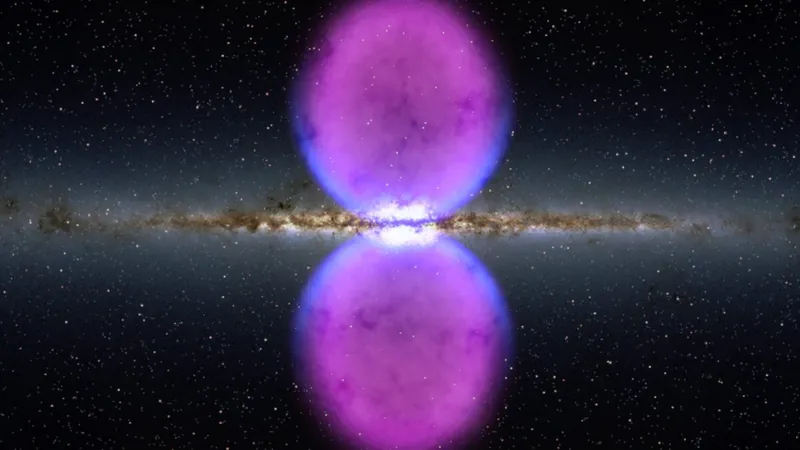
Ice Cubes in a Volcano: Mysterious Hydrogen Clouds Stun Scientists in the Milky Way’s Core
2025-07-19
Author: John Tan
Astounding Discoveries at the Galaxy's Heart
In the heart of the Milky Way lies a captivating enigma: colossal, balloon-shaped structures of high-energy radiation known as the Fermi bubbles. These massive formations stretch thousands of light-years above and below our galaxy’s plane and are believed to be the remnants of a cataclysmic event in the recent cosmic past.
A Chilling Surprise Inside Hot Bubbles
A groundbreaking new study, using the National Science Foundation’s Green Bank Telescope in West Virginia, has uncovered something extraordinary within these fiery giants—cold hydrogen clouds defying expectations in an otherwise searing environment. These clouds, surprising as they are, are relatively youthful in cosmic terms, hinting that they are only a few million years old.
Unlocking the Mystery of the Fermi Bubbles
Discovered by NASA’s Fermi Gamma-ray Space Telescope in 2010, the Fermi bubbles feature an hourglass structure, each lobe peaking at about 25,000 light-years. Composed primarily of gamma rays and high-energy cosmic rays, their formation is likened to a volcanic eruption, erupting suddenly and violently—an event so sudden it left astronomers reeling.
Ice Cubes in a Cosmic Volcano?
The peculiar cold gas found within the bubbles raises a pivotal question: how does such cool gas thrive amidst scorching temperatures exceeding 1 million degrees Kelvin? These cold hydrogen clouds, measuring about 10,000 degrees Kelvin, appear almost contradictory in their hostile surroundings. Andrew Fox, an astronomer involved in the study, eloquently compared their presence to "finding ice cubes in a volcano." This unexpected discovery paints a vivid picture of survival amidst chaos and offers vital insights into the galaxy’s evolution.
Revealing the Young Age of the Bubbles
Given the extreme conditions, it seems astonishing that these clouds have not been annihilated. Their existence indicates the Fermi bubbles might be much younger than previously thought. "If the Fermi bubbles were 10 million years or older, these clouds wouldn't even be around," said Rongmon Bordoloi, highlighting the timeline of this cosmic tale.
Unraveling the Galactic Wind Mystery
The researchers propose that these clouds were swept away from the Milky Way's core, carried by the hot winds generated by the formation of the Fermi bubbles. Jay Lockman, another co-author, provided a relatable analogy: "Just as true wind is invisible unless tracked by clouds on Earth, the hot winds from the Milky Way remain unseen. However, we can detect their presence through the radio emissions emitted by the cold clouds they transport."
A New Chapter in Galactic Understanding
This stunning revelation not only reshapes our understanding of the Fermi bubbles but also illuminates the dynamic and often violent processes behind galaxy evolution. As scientists continue their explorations, who knows what other cosmic surprises the Milky Way might hold?



 Brasil (PT)
Brasil (PT)
 Canada (EN)
Canada (EN)
 Chile (ES)
Chile (ES)
 Česko (CS)
Česko (CS)
 대한민국 (KO)
대한민국 (KO)
 España (ES)
España (ES)
 France (FR)
France (FR)
 Hong Kong (EN)
Hong Kong (EN)
 Italia (IT)
Italia (IT)
 日本 (JA)
日本 (JA)
 Magyarország (HU)
Magyarország (HU)
 Norge (NO)
Norge (NO)
 Polska (PL)
Polska (PL)
 Schweiz (DE)
Schweiz (DE)
 Singapore (EN)
Singapore (EN)
 Sverige (SV)
Sverige (SV)
 Suomi (FI)
Suomi (FI)
 Türkiye (TR)
Türkiye (TR)
 الإمارات العربية المتحدة (AR)
الإمارات العربية المتحدة (AR)